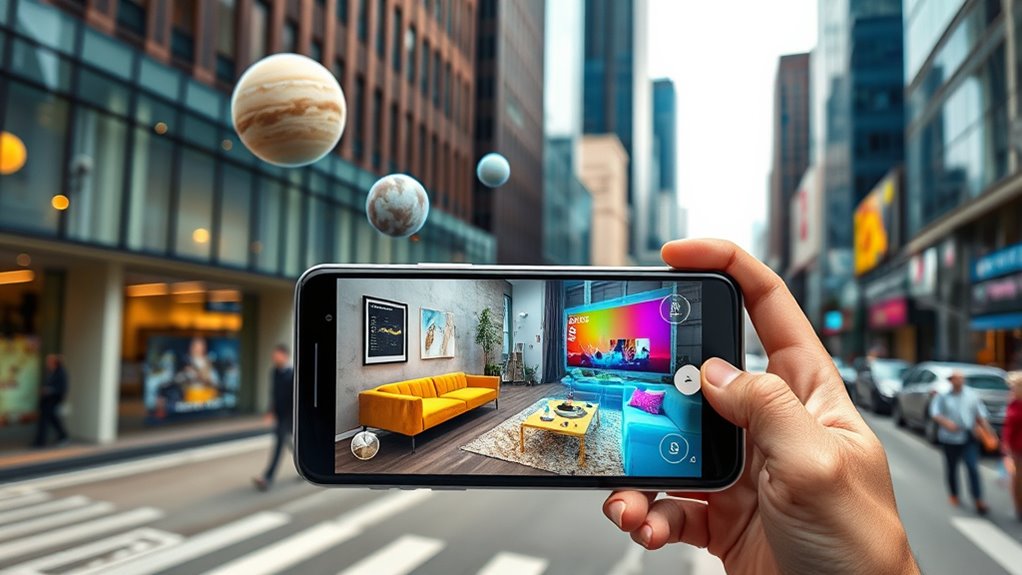Augmented reality apps are changing how you shop, learn, navigate, and create daily. You can try virtual shopping apps to see clothes on yourself instantly or use AR for interactive learning with 3D models of historical artifacts. Navigation becomes easier with AR overlays directing your routes, and home decor is simplified by visualizing furniture in your space. If you’re curious about more innovative AR uses, keep exploring to discover even more exciting ways it’s shaping everyday life.
Key Takeaways
- Discover virtual shopping apps that let you browse and try on clothes or accessories in real time using AR.
- Explore educational AR apps that bring textbooks and scientific concepts to life with interactive 3D models.
- Use navigation and home décor apps to visualize routes or furniture placement directly in your environment.
- Experience storytelling and content creation tools that incorporate immersive AR visuals for entertainment and education.
- Learn how AR enhances daily routines by offering smarter shopping, learning, and interactive experiences through accessible apps.

Have you ever wondered how augmented reality (AR) is seamlessly integrating into your daily routine? These days, AR isn’t just about flashy games or futuristic gimmicks; it’s transforming the way you shop, learn, and interact with the world around you. One of the most exciting ways AR is making its mark is through virtual shopping. Imagine walking into your favorite store without even leaving your couch. With AR apps, you can browse products virtually, trying on clothes or accessories in real time, just like you’re in a physical shop. You point your phone at yourself or a mirror, and the AR overlays let you see how a new jacket fits or how those new shoes look on your feet—without any guesswork. This technology saves time, reduces returns, and makes shopping more personalized and fun. It’s like having a fashion consultant right in your pocket. As AR continues to evolve, virtual shopping experiences are becoming more realistic and immersive, blurring the lines between physical and digital retail. You get to make smarter purchasing decisions, all while enjoying the convenience of shopping from home.
AR’s influence extends beyond shopping into interactive education, transforming how you learn and explore new concepts. Imagine studying ancient civilizations with a quick scan of a textbook page that springs to life with 3D models of historical sites or artifacts. You can walk around and examine them from every angle, gaining a deeper understanding that static images can’t provide. This kind of interactive education makes learning more engaging and memorable. It’s especially useful for students, teachers, or anyone curious about the world. You don’t have to rely solely on textbooks or videos; AR offers an immersive experience that brings subjects to life. Whether it’s exploring the human body in 3D, understanding complex scientific phenomena, or practicing new skills through virtual simulations, AR makes education more accessible and compelling. These apps foster curiosity and help you grasp difficult concepts by turning passive learning into active discovery. Additionally, anime movies demonstrate how storytelling can be enhanced through innovative visual techniques, inspiring AR developers to create more captivating educational content.
In everyday life, AR is also helping you navigate your environment more efficiently. From interactive maps that overlay directions onto real-world streets to furniture apps that show you how a new couch fits in your living room, AR is making tasks easier and more intuitive. As the technology becomes more integrated into your smartphone and wearable devices, it’s not just a novelty — it’s a practical tool. Whether you’re shopping, learning, or simply exploring your surroundings, AR offers a richer, more connected experience. It’s easy to see how this technology is shaping your daily routines, making them more engaging, efficient, and fun.
Frequently Asked Questions
How Secure Is My Personal Data in AR Apps?
You might wonder how secure your personal data is in AR apps. While some apps prioritize privacy concerns, it is crucial to check their data encryption protocols. Many use encryption to protect your information, but vulnerabilities still exist, especially if the app has weak security measures. Always review privacy policies and stick to reputable AR apps to minimize risks and keep your data safer as you enjoy augmented reality experiences.
Can AR Apps Be Used Offline Effectively?
You might wonder if AR apps can work offline effectively. The answer depends on the app’s offline functionality and how it’s designed for performance. Some AR apps have limited offline features, relying on internet for updates or cloud data, which can affect app performance. However, many AR apps with robust offline capabilities deliver smooth experiences, allowing you to explore augmented reality without internet, making them practical for various situations.
What ARe the Hardware Requirements for High-Quality AR Experiences?
Like Da Vinci’s sketches, high-quality AR experiences demand precise tools. You need AR hardware with powerful processors, high-resolution displays, and accurate sensors for seamless interaction. Device compatibility is key, so make certain your smartphone or AR glasses meet the specifications. A fast, stable internet connection also boosts performance. Without these essentials, your AR adventures might feel more rough sketches than masterpieces. Don’t compromise—invest in the right hardware to open AR’s full potential.
How Does AR Impact Battery Life on Devices?
AR can substantially impact your device’s battery life, causing increased battery drain due to continuous processing and rendering. To minimize this, you should enable power optimization features and close unnecessary apps while using AR. Using lower graphics settings or limiting AR sessions helps conserve energy. Keep your device updated, as developers often include battery efficiency improvements to reduce the impact of AR on overall power consumption.
ARe AR Apps Accessible for Users With Disabilities?
Think of AR apps as bridges connecting everyone. You’ll find many designed with disability accessibility and inclusive design in mind, making sure users with diverse needs can enjoy them. Developers now prioritize features like voice commands, subtitles, and simplified interfaces. This effort guarantees that AR technology becomes more inclusive, allowing you to experience its benefits regardless of physical or sensory challenges. Accessibility isn’t just an add-on; it’s shaping the future of AR for all.
Conclusion
As you explore these AR apps, you’ll find that the line between the digital and real world becomes wonderfully blurred. They gently invite you to see everyday moments in a fresh light, adding a touch of magic and curiosity to your routine. Embrace this subtle shift—sometimes, a little bit of augmented reality can brighten your day and inspire your imagination in ways you never expected. After all, life’s more interesting when you see it through a new lens.









